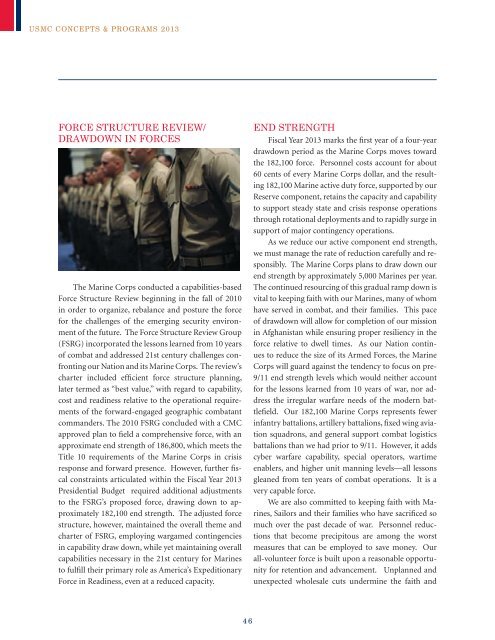USMC Concepts & Programs 2013 - Defense Innovation Marketplace
USMC Concepts & Programs 2013 - Defense Innovation Marketplace
USMC Concepts & Programs 2013 - Defense Innovation Marketplace
You also want an ePaper? Increase the reach of your titles
YUMPU automatically turns print PDFs into web optimized ePapers that Google loves.
<strong>USMC</strong> <strong>Concepts</strong> & <strong>Programs</strong> <strong>2013</strong><br />
Force Structure Review/<br />
Drawdown in Forces<br />
The Marine Corps conducted a capabilities-based<br />
Force Structure Review beginning in the fall of 2010<br />
in order to organize, rebalance and posture the force<br />
for the challenges of the emerging security environment<br />
of the future. The Force Structure Review Group<br />
(FSRG) incorporated the lessons learned from 10 years<br />
of combat and addressed 21st century challenges confronting<br />
our Nation and its Marine Corps. The review’s<br />
charter included efficient force structure planning,<br />
later termed as “best value,” with regard to capability,<br />
cost and readiness relative to the operational requirements<br />
of the forward-engaged geographic combatant<br />
commanders. The 2010 FSRG concluded with a CMC<br />
approved plan to field a comprehensive force, with an<br />
approximate end strength of 186,800, which meets the<br />
Title 10 requirements of the Marine Corps in crisis<br />
response and forward presence. However, further fiscal<br />
constraints articulated within the Fiscal Year <strong>2013</strong><br />
Presidential Budget required additional adjustments<br />
to the FSRG’s proposed force, drawing down to approximately<br />
182,100 end strength. The adjusted force<br />
structure, however, maintained the overall theme and<br />
charter of FSRG, employing wargamed contingencies<br />
in capability draw down, while yet maintaining overall<br />
capabilities necessary in the 21st century for Marines<br />
to fulfill their primary role as America’s Expeditionary<br />
Force in Readiness, even at a reduced capacity.<br />
End Strength<br />
Fiscal Year <strong>2013</strong> marks the first year of a four-year<br />
drawdown period as the Marine Corps moves toward<br />
the 182,100 force. Personnel costs account for about<br />
60 cents of every Marine Corps dollar, and the resulting<br />
182,100 Marine active duty force, supported by our<br />
Reserve component, retains the capacity and capability<br />
to support steady state and crisis response operations<br />
through rotational deployments and to rapidly surge in<br />
support of major contingency operations.<br />
As we reduce our active component end strength,<br />
we must manage the rate of reduction carefully and responsibly.<br />
The Marine Corps plans to draw down our<br />
end strength by approximately 5,000 Marines per year.<br />
The continued resourcing of this gradual ramp down is<br />
vital to keeping faith with our Marines, many of whom<br />
have served in combat, and their families. This pace<br />
of drawdown will allow for completion of our mission<br />
in Afghanistan while ensuring proper resiliency in the<br />
force relative to dwell times. As our Nation continues<br />
to reduce the size of its Armed Forces, the Marine<br />
Corps will guard against the tendency to focus on pre-<br />
9/11 end strength levels which would neither account<br />
for the lessons learned from 10 years of war, nor address<br />
the irregular warfare needs of the modern battlefield.<br />
Our 182,100 Marine Corps represents fewer<br />
infantry battalions, artillery battalions, fixed wing aviation<br />
squadrons, and general support combat logistics<br />
battalions than we had prior to 9/11. However, it adds<br />
cyber warfare capability, special operators, wartime<br />
enablers, and higher unit manning levels—all lessons<br />
gleaned from ten years of combat operations. It is a<br />
very capable force.<br />
We are also committed to keeping faith with Marines,<br />
Sailors and their families who have sacrificed so<br />
much over the past decade of war. Personnel reductions<br />
that become precipitous are among the worst<br />
measures that can be employed to save money. Our<br />
all-volunteer force is built upon a reasonable opportunity<br />
for retention and advancement. Unplanned and<br />
unexpected wholesale cuts undermine the faith and<br />
46

















